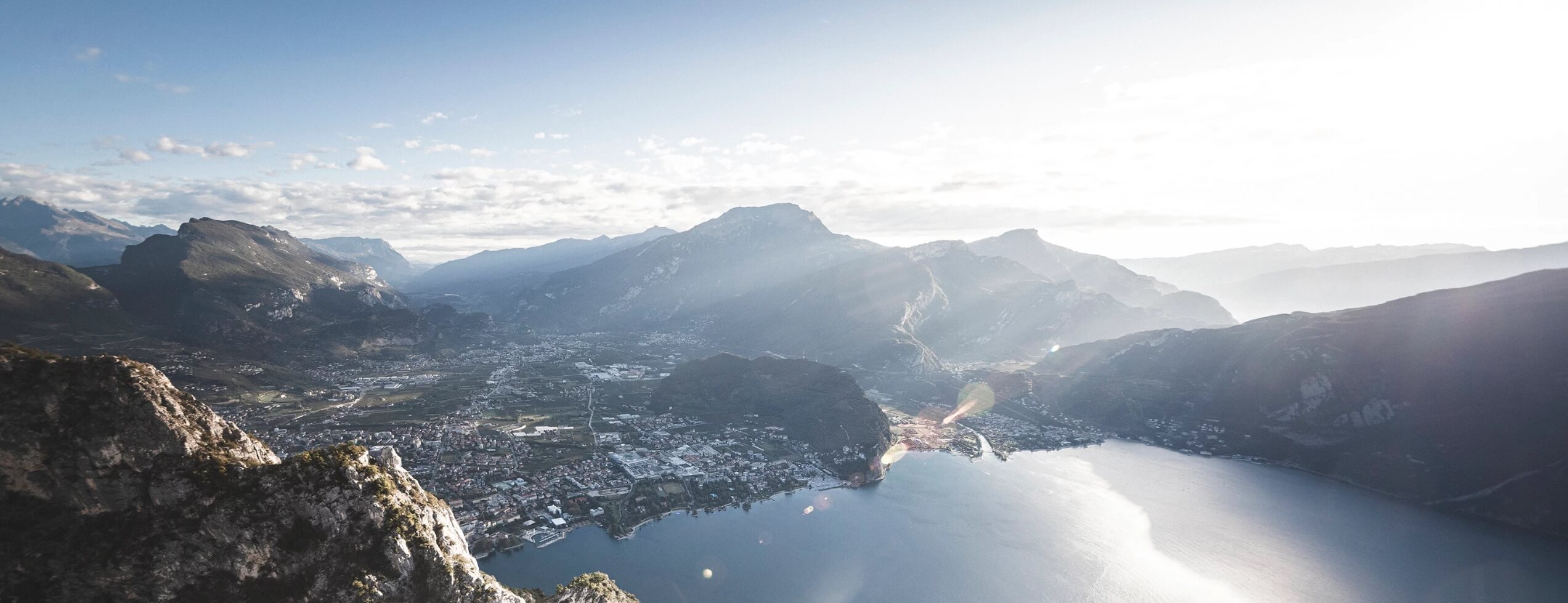
Spectacular Mediterranean scenery rises from the waters and up over steep mountain slopes to the blue heavens, all with a promise of the great outdoors. Sporting adventures and pleasurable experiences here vie for the favour of guests, as Bella Italia can always produce culinary delights in villages that bear witness to a lively culture.
Benvenuti nel Garda Trentino.


The scents in Riva del Garda are of olive oil, lemon juice, bay leaves and fine wine, mountain traditions and Mediterranean ease.
Nestling between Lake Garda and the Brenta Dolomites, Riva del Garda is the very epicentre of Garda Trentino
A ruined castle perches on a steep rock directly above the town of Arco, whose historic centre lies like a semicircle around the slopes of the castle mount. Perhaps it was not mere chance that led to its name Arco – “arch” or “bow” in English.
And suddenly the rock faces fall away and reveal the view that stretches way over the blue of Lake Garda. Torbole sul Garda has found its place on the shore, at the foot of Monte Baldo and, now as always, knows how to captivate guests with its charm.
Located between the Lake Garda and the the Valle del Chiese, the Ledro Valley is a land bound north and south by spectacular peaks that soar to heights of over 2,000 metres. This natural setting holds thirteen villages, each with a bewitching charm. The roofs of the houses rise up between fragrant woods and meadows or give colour to the shores of Lake Ledro.
Comano offers a placid succession of rural landscapes and the lively gurgling of the thermal spring at the foot of the silently spectacular Brenta Dolomites, an oasis of tranquillity and well-being that invites you to follow the rhythms of nature.
The Comano area encloses – just as a precious casket - Fiavé, Comano Terme, Bleggio Superiore, Stenico.
Up in the hills high above Riva del Garda, the village of Tenno perches between olive groves, vineyards and alpine rock formations. Facing south and nestling among spectacular plant life, this location always offers clear views as it proudly presents Lake Garda below.
One of the oldest municipalities in the Sarca Valley, Dro, lies between the three enchanting lakes of the Garda Trentino region – Lake Garda, Lake Cavedine and Lake Toblino. Slightly higher is Drena, a mountain village of prehistoric origin, shaped by Roman and Medieval influences.
The Valle dei Laghi is a subalpine lake district between Lake Garda and Trento that extends north of the village of Sarche, where visitors can embark on a spectacular journey through an enchanting watery landscape. Apart from its numerous lakes, the area is also known for the popular Vino Santo, not to mention its large number of grappa varieties.
A journey to Val di Gresta is always intentional. To reach it, you have to leave the main route running along the valley floor, winding up hairpin bends at the foot of Mount Stivo. Those who embark on this adventure are rewarded with a priceless sensation, as if they've stumbled upon a hidden realm where the myriad shades of green reign supreme.

The scents in Riva del Garda are of olive oil, lemon juice, bay leaves and fine wine, mountain traditions and Mediterranean ease.
Nestling between Lake Garda and the Brenta Dolomites, Riva del Garda is the very epicentre of Garda Trentino

A ruined castle perches on a steep rock directly above the town of Arco, whose historic centre lies like a semicircle around the slopes of the castle mount. Perhaps it was not mere chance that led to its name Arco – “arch” or “bow” in English.

And suddenly the rock faces fall away and reveal the view that stretches way over the blue of Lake Garda. Torbole sul Garda has found its place on the shore, at the foot of Monte Baldo and, now as always, knows how to captivate guests with its charm.

Located between the Lake Garda and the the Valle del Chiese, the Ledro Valley is a land bound north and south by spectacular peaks that soar to heights of over 2,000 metres. This natural setting holds thirteen villages, each with a bewitching charm. The roofs of the houses rise up between fragrant woods and meadows or give colour to the shores of Lake Ledro.

Comano offers a placid succession of rural landscapes and the lively gurgling of the thermal spring at the foot of the silently spectacular Brenta Dolomites, an oasis of tranquillity and well-being that invites you to follow the rhythms of nature.
The Comano area encloses – just as a precious casket - Fiavé, Comano Terme, Bleggio Superiore, Stenico.

Up in the hills high above Riva del Garda, the village of Tenno perches between olive groves, vineyards and alpine rock formations. Facing south and nestling among spectacular plant life, this location always offers clear views as it proudly presents Lake Garda below.

One of the oldest municipalities in the Sarca Valley, Dro, lies between the three enchanting lakes of the Garda Trentino region – Lake Garda, Lake Cavedine and Lake Toblino. Slightly higher is Drena, a mountain village of prehistoric origin, shaped by Roman and Medieval influences.

The Valle dei Laghi is a subalpine lake district between Lake Garda and Trento that extends north of the village of Sarche, where visitors can embark on a spectacular journey through an enchanting watery landscape. Apart from its numerous lakes, the area is also known for the popular Vino Santo, not to mention its large number of grappa varieties.

A journey to Val di Gresta is always intentional. To reach it, you have to leave the main route running along the valley floor, winding up hairpin bends at the foot of Mount Stivo. Those who embark on this adventure are rewarded with a priceless sensation, as if they've stumbled upon a hidden realm where the myriad shades of green reign supreme.





